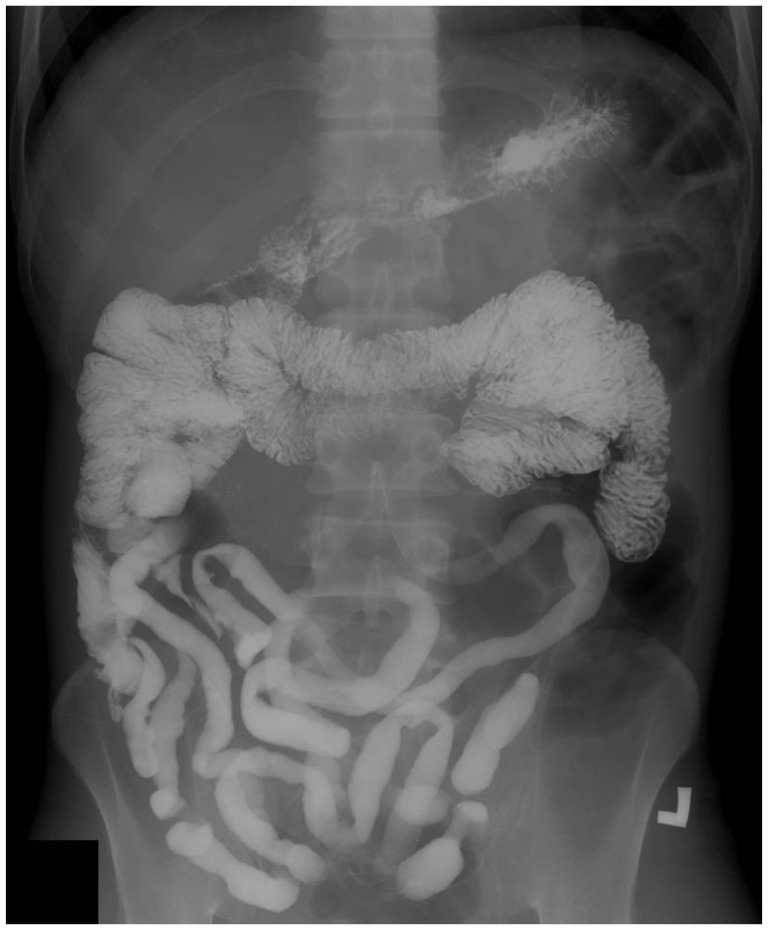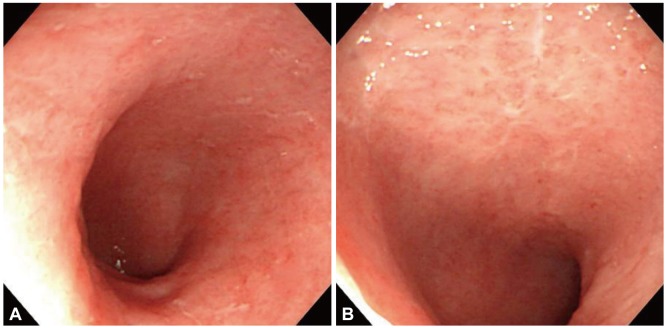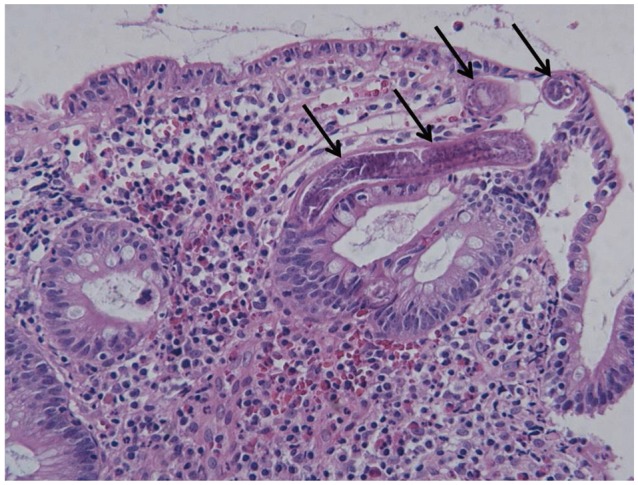Clin Endosc.
2013 Nov;46(6):675-678.
Intestinal Capillariasis Diagnosed by Endoscopic Biopsy
- Affiliations
-
- 1Division of Gastroenterology and Hepatology, Department of Internal Medicine, Gachon University Gil Medical Center, Gachon University of Medicine and Science, Incheon, Korea. yskoomd@hanmail.net
Abstract
- Many new parasitic infections have emerged in Korea, with >35 new species appearing since the 1980s. Among them, Capillaria species are unique for contributing to morbidity in many countries as well as in Korea. Since the first reported case of a 41-year-old male patient diagnosed with intestinal capillariasis in 1991, a total of six cases have been reported thus far. In this case report, we present another imported case of intestinal capillariasis in Korea, in which a 42-year-old male patient presented with intractable diarrhea and weight loss. The diagnosis was confirmed by biopsy of the ileum. The pathognomonic radiographic presentation of a ribbon-like appearance in a small bowel series was crucial in raising an early suspicion of capillariasis and in deciding to perform diagnostic biopsy.
MeSH Terms
Figure
Reference
-
1. Chai JY. Emerging parasitic diseases in Korea. J Korean Med Assoc. 2007; 50:946–958.
Article2. Chitwood MB, Valesquez C, Salazar NG. Capillaria philippinensis sp. n. (Nematoda: Trichinellida), from the intestine of man in the Philippines. J Parasitol. 1968; 54:368–371. PMID: 5647122.
Article3. Lee SH, Hong ST, Chai JY, et al. A case of intestinal capillariasis in the Republic of Korea. Am J Trop Med Hyg. 1993; 48:542–546. PMID: 8480863.
Article4. Hong ST, Kim YT, Choe G, et al. Two cases of intestinal capillariasis in Korea. Korean J Parasitol. 1994; 32:43–48. PMID: 8167107.
Article5. Lee SH, Rhee PL, Lee JH, et al. A case of intestinal capillariasis: fourth case report in Korea. Korean J Gastroenterol. 1999; 34:542–546.6. Kwon Y, Jung HY, Ha HK, Lee I. An imported case of intestinal capillariasis presenting as protein-losing enteropathy. Korean J Pathol. 2000; 34:235–238.7. Jung WT, Kim HJ, Min HJ, et al. An indigenous case of intestinal capillariasis with protein-losing enteropathy in Korea. Korean J Parasitol. 2012; 50:333–337. PMID: 23230331.
Article8. Bickford AA, Gaafar SM. Multiple capillariasis in game-farm pheasants. Avian Dis. 1966; 10:428–437. PMID: 6008334.
Article9. Jortner BS, Helmboldt CF, Pirozok RP. Small intestinal histopathology of spontaneous capillariasis in the domestic fowl. Avian Dis. 1967; 11:154–169. PMID: 6035887.
Article10. Hwang KP. Human intestinal capillariasis (Capillaria philippinensis) in Taiwan. Zhonghua Min Guo Xiao Er Ke Yi Xue Hui Za Zhi. 1998; 39:82–85. PMID: 9599894.11. Ahmed L, el-Dib NA, el-Boraey Y, Ibrahim M. Capillaria philippinensis: an emerging parasite causing severe diarrhoea in Egypt. J Egypt Soc Parasitol. 1999; 29:483–493. PMID: 10605499.12. Saichua P, Nithikathkul C, Kaewpitoon N. Human intestinal capillariasis in Thailand. World J Gastroenterol. 2008; 14:506–510. PMID: 18203280.
Article13. Fan Z, Huang Y, Qian S, et al. Serious diarrhea with weight loss caused by Capillaria philippinensis acquired in China: a case report. BMC Res Notes. 2012; 5:554. PMID: 23035938.
Article14. Dronda F, Chaves F, Sanz A, Lopez-Velez R. Human intestinal capillariasis in an area of nonendemicity: case report and review. Clin Infect Dis. 1993; 17:909–912. PMID: 8286640.
Article16. Cross JH, Basaca-Sevilla V. Intestinal capillariasis. Prog Clin Parasitol. 1989; 1:105–119. PMID: 2491692.
Article
- Full Text Links
- Actions
-
Cited
- CITED
-
- Close
- Share
- Similar articles
-
- Two cases of intestinal capillariasis in Korea
- An Imported Case of Intestinal Capillariasis Presenting as Protein-Losing Enteropathy
- An Indigenous Case of Intestinal Capillariasis with Protein-Losing Enteropathy in Korea
- A Case of Intestinal Capillariasis : Fourth Case Report in Korea
- A Case of Gastritis Associated with Gastric Capillariasis




